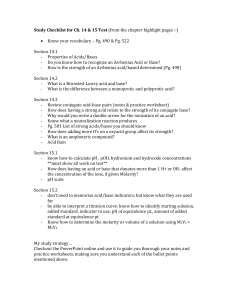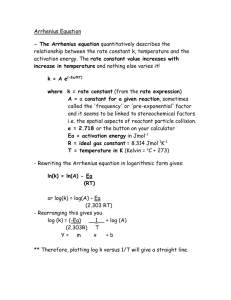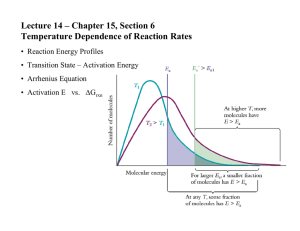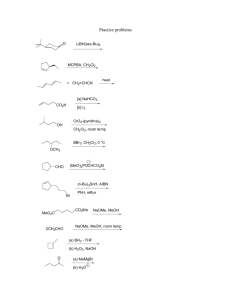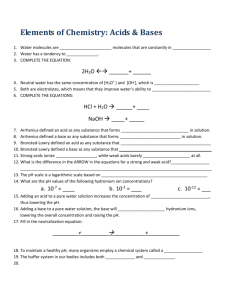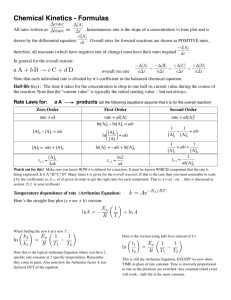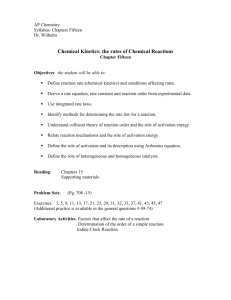Example Arrhenius plot Physical Chemistry Lecture 6 Mechanisms of chemical reactions
advertisement
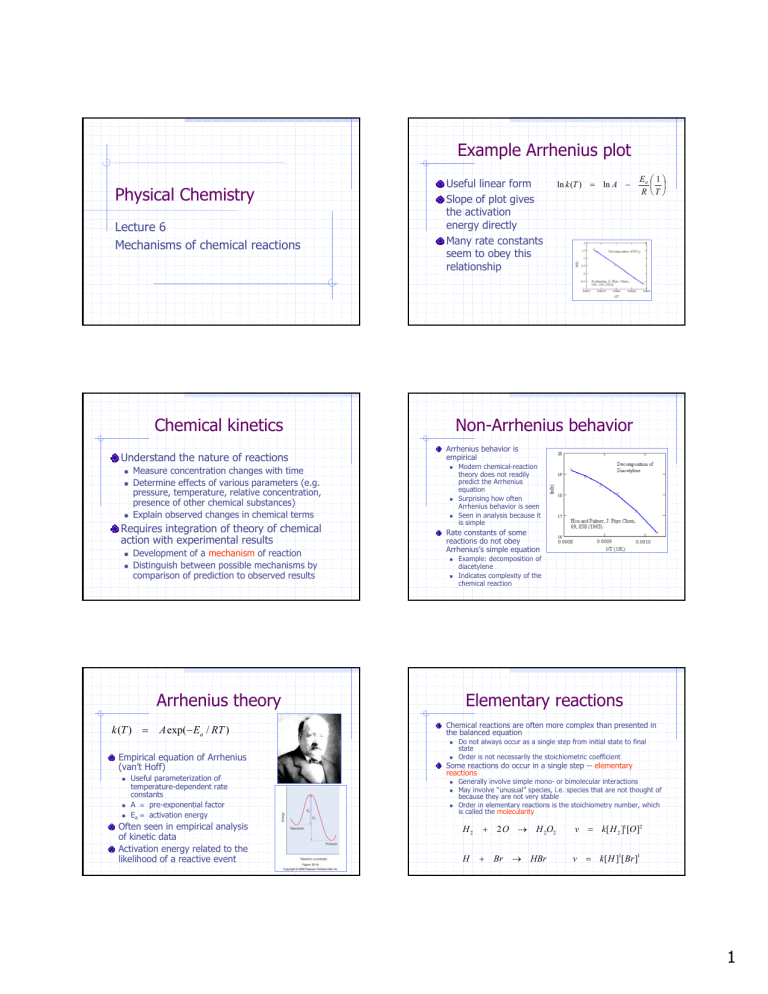
Example Arrhenius plot Physical Chemistry Lecture 6 Mechanisms of chemical reactions Useful linear form Slope of plot gives the activation energy directly Many rate constants seem to obey this relationship Chemical kinetics Understand the nature of reactions Measure concentration changes with time Determine effects of various parameters (e.g. pressure, temperature, relative concentration, presence of other chemical substances) Explain observed changes in chemical terms Requires integration of theory of chemical action with experimental results Development of a mechanism of reaction Distinguish between possible mechanisms by comparison of prediction to observed results A exp( Ea / RT ) Arrhenius behavior is empirical Useful parameterization of temperature-dependent rate constants A pre-exponential factor Ea activation energy Often seen in empirical analysis of kinetic data Activation energy related to the likelihood of a reactive event Modern chemical-reaction theory does not readily predict the Arrhenius equation Surprising how often Arrhenius behavior is seen Seen in analysis because it is simple Rate constants of some reactions do not obey Arrhenius’s simple equation Example: decomposition of diacetylene Indicates complexity of the chemical reaction Elementary reactions Chemical reactions are often more complex than presented in the balanced equation Empirical equation of Arrhenius (van’t Hoff) Ea 1 R T Non-Arrhenius behavior Arrhenius theory k (T ) ln k (T ) ln A Do not always occur as a single step from initial state to final state Order is not necessarily the stoichiometric coefficient Some reactions do occur in a single step -- elementary reactions Generally involve simple mono- or bimolecular interactions May involve “unusual” species, i.e. species that are not thought of because they are not very stable Order in elementary reactions is the stoichiometry number, which is called the molecularity H2 H 2 O H 2O2 Br HBr v k[ H 2 ]1[O ]2 v k[ H ]1[ Br ]1 1 Complex reactions Complex reactions are considered to be comprised of a series of elementary reactions The simultaneous occurrence of these elementary reactions leads to an overall reaction mechanism Example: reaction of hydrogen and bromine to produce HBr H2 Br2 Parallel reactions 2 HBr Elementary reaction mechanism Br2 Br H 2 H Br2 H HBr Br Br 2 Br HBr H HBr Br Br H2 Br2 Analytical expressions for concentrations are possible kI P Allows mathematical expressions for concentrations At reaction end, both products are present kA A B Example: Reaction goes to completion; neglect reverse reaction B kB A Can always postulate a reverse reaction to any reaction [ A(t )] [ A(0)]e k At [ I (t )] k A [ A(0)] k At e e kI t kI k A k e k I t k I e k At [ P(t )] [ A(0)]1 A kI k A kA e ( k A k B )t k A kB kA [ B (t )] [ A(0)] kA kB kA e ( k A k B ) t k A kB Reversible reactions In principle, all reactions are reversible In practice, for many reactions equilibrium lies at one extreme or the other Examples of equilibrium kB A B kC A C [ A(t )] [ A(0)]e ( k B kC )t [ B(t )] [ A(0)] kB 1 e ( k B kC ) t k B kC kC [C (t )] [ A(0)] 1 e ( k B kC ) t k B kC When reverse reaction is not inconsequential, it must be included Reversible first-order reactions can be solved mathematically kB [ A(t )] [ A(0)] kA kB Parallel first-order reactions One reactant reacts along two different pathways Consider both reactions to be of first order Three parallel reactions Ratios of equilibrium product concentrations give ratios of rate constants In kinetics, one often neglects steps considered inconsequential kA A I I kB kC [C ]eq Reversible reactions Sequential two-step reaction Two subsequent first-order steps Rate equations for both steps are integrable [ B ]eq Ratio of final concentrations determined by the rate constants Example: reactions of benzyl penicillin under acidic conditions Chair – boat interchange of cyclohexane Monomer-dimer conversion NH2 N O H O O H O R NH2 R Proflavin Carboxylic acid O 2 R O H 2 Simple collision theory of gasphase kinetics To participate in a A B Products bimolecular reaction, molecules must v Z AB approach each other vmax Z AB AB v AB ,ave n*A nB* closely 8kT AB N 0 [ A][ B ] SCT: gas-phase reaction rate proportional to collision frequency SCT does not generally AB collision cross section agree with experimental rates 8kT k max AB N 0 Points out how to think about theory of chemical reactions Experimental SCT and Arrhenius parameters p steric factor Emin minimum energy for reaction 8kT p AB N 0 8kT p AB N 0 23.85 14.6 0.039 25.42 15.5 0.076 O + O3 2 O2 273 –900 23.21 20.0 0.037 N + NO N2 + O 300 – 6000 23.28 ~0 0.040 CH3 + C6H6 CH4 + C6H5 456 – 600 17.04 38.5 2.7 10-5 BH3 + BH3CO CO + B2H6 273 – 333 19.34 29.3 PH3 + B2H6 PH3BH3 +BH3 249 – 273 14.97 47.7 7.4 10-6 CO + O2 O + CO2 2400 – 3000 21.97 213.4 4.3 10-3 F2 + ClO2 F + FClO2 227 – 247 16.37 33.5 5.2 10-5 Activated-complex theory Developed by H. Eyring, M. Evans, and M. Polanyi Activated complex is a precursor to products exp( Emin / RT ) [ A][ B] Predicts a temperaturedependent Arrhenius activation energy Predicts a temperaturedependent Arrhenius preexponential factor [ A B ] Can be thought of as a “decomposition” [ A B] Fast equilibrium between reactants and activated complex Ae Ea / RT k SCT (T ) p 8kT e Emin / RT Arrhenius behavior Ea ln k T RT 2 By comparison of derivatives RT Ea Emin 2 A p AB N 0 8kT e B [ A B ] A Gives products by a firstorder process Relation of SCT parameters to Arrhenius parameters Exists in small amounts Not seen, like a reactive intermediate Can transform in two ways Revert to reactants Form products exp( Emin / RT ) k Arr (T ) 2.9 10-4 (a) The range of validity is expressed in kelvins. (b) A is in dm3 mol-1 s-1. (c) Ea is in kJ mol-1. Like van der Waals’s improvement of the idealgas law Many experimental data reported as Arrhenius behavior Comparison with SCT necessary to connect theory and experiment p 0.088 200 – 500 k Ea 39.3 1000 - 1700 v Z AB p exp( Emin / RT ) Empirically add two factors to account for these features ln A 24.61 H + HCl H2 + Cl SCT neglects two features Collision must be sufficiently energetic to cause reaction Molecules must have proper orientation to allow reaction Range 300 – 750 H + HBr H2 + Br “Correcting” simple collision theory Reaction H + D2 HD + H A B Products Activated-complex mathematics Reaction velocity proportional to activatedcomplex concentration Quasi-equilibrium between reactants and activated complex Statistical mechanics defines disappearance rate constant of activated complex, f Defines the enthalpy and entropy of activation A means to parameterize the rate constant v v f C K a a A aB C C C AC B fK C AC B C S H RT exp C AC B exp hN 0C R RT 3 Eyring’s equation Activated-complex biomolecular rate constant, k2, in terms of the parameters of the activated complex Temperature and the Arrhenius model Why does the Arrhenius model work so well in many cases? S H RT exp k2 exp hN 0C R RT Not Arrhenius-like behavior OH CH3 H2 O From slope and intercept H = 12.0 kJ/mol S = -33.2 J/K-mol Around room temperature, RT/2 ~ 1.2 kJ/mole RT/2 varies slowly with temperature compared to the exponential function Ea tends to be much larger than RT/2 for many reactions Emin and Ea both appear to be approximately constant Computer modeling of potential-energy surfaces Potential energy of configuration of molecules controls interaction Model time-dependent approach of molecules with (classical or quantum) simulation Example: Evaluate by plotting ln(k/T) versus 1/T Example Can convert between Arrhenius parameters and Eyring parameters Evaluation of Eyring parameters CH4 Empirical Not predicted by the simplest theory Not predicted by activated-complex theory Partial answer Difficult to distinguish from Arrhenius behavior under many circumstances Another means to parameterize the rate constant T. Gierczak, R. Talukdar, S. Herndon, G. Vaghjiani, A. Ravishankara, J. Phys. Chem, 101A, 3125 (1997). Alternative to Arrhenius parameters Relation of Eyring and Arrhenius parameters Need to be able to convert between the two parameterizations of kinetic data Use differential of Eyring form to show relationships Phase/Molecularity Solution Activation Energy, Ea H RT Pre-exponential factor, A eRT S exp( ) hN 0 LC R Gas, unimolecular H RT eRT S exp( ) hN 0 R Gas, bimolecular H 2 RT e 2 RT S exp( ) hN 0C R Gas, termolecular H 3RT e3 RT S exp( ) hN 0C 2 R D + H2 HD + H Several parameters Distances Angles Computer simulation of gasphase reactions Reactive encounters go through the reactive region Unreactive encounter goes to the reactive region and return in the same channel M. Karplus, R. N. Porter, and R. D. Shamra, J. Chem. Phys., 43,3258 (1965). 4 Simulation of a reactive event Follow the time course of the approach Atoms exchange partners Time scale is very short Repeat many times and measure fraction of times that reactive events happen Summary Theories of simple reactions Simple collision theory Modified collision theory Computer simulation Activated-complex theory Parameterization of reaction dynamics Arrhenius activation energy and pre-exponential factor Equilibrium thermodynamic properties of activated complex from Eyring theory Simple collision theory parameters 5
